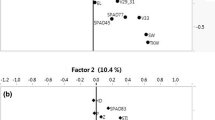Abstract
Improved winter wheat (Triticum aestivum L.) cultivars are needed for the diverse environments in Central and West Asia to improve rural livelihoods. This study was conducted to determine the performance of elite winter wheat breeding lines developed by the International Winter Wheat Improvement Program (IWWIP), to analyze their stability across diverse environments, and to identify superior genotypes that could be valuable for winter wheat improvement or varietal release. One hundred and one advanced winter wheat breeding lines and four check cultivars were tested over a 5-year period (2004–2008). Grain yield and agronomic traits were analyzed. Stability and genotypic superiority for grain yield were determined using genotype and genotype × environment (GGE) biplot analysis. The experimental genotypes showed high levels of grain yield in each year, with mean values ranging from 3.9 to 6.7 t ha−1. A set of 25 experimental genotypes was identified. These were either equal or superior to the best check based on their high mean yield and stability across environments as assessed by the GGE biplot analysis. The more stable high yielding genotypes were ID800994.W/Falke, Agri/Nac//Attila, ID800994W/Vee//F900K/3/Pony/Opata, AU//YT542/N10B/3/II8260/4/JI/Hys/5/Yunnat Esskiy/6/KS82W409/Spn and F130-L-1-12/MV12. The superior genotypes also had acceptable maturity, plant height and 1,000-kernel weight. Among the superior lines, Agri/Nac//Attila and Shark/F4105W2.1 have already been proposed for release in Kyrgyzstan and Georgia, respectively. The findings provide information on wide adaptation of the internationally important winter wheat genotypes, and demonstrate that the IWWIP program is enriching the germplasm base in the region with superior winter wheat genotypes to the benefit of national and international winter wheat improvement programs.






Similar content being viewed by others
Abbreviations
- CIMMYT:
-
International Maize and Wheat Improvement Center
- ICARDA:
-
International Center for Agricultural Research in the Dry Areas
- IWWIP:
-
International Winter Wheat Improvement Program
- IWWYT:
-
International Winter Wheat Yield Trial
- TKW:
-
1,000-kernel weight
References
Braun HJ, Ekiz H, Eser V, Keser M (1998) Breeding priorities of winter wheat programs. In: Braun HJ, Altay F, Kronstad WE, Beniwal SPS, McNab A et al (eds) Wheat: prospects for global improvement. Kluwer, Dordrecht, pp 553–560
CIMMYT (2005) Rapid progress in winter wheat breeding has large impact. http://www.cimmyt.org/english/docs/ann_report/2004/publGoods/rapidProgress.htm Verified 8 October, 2008
FAO (2008) Statistical database. www.fao.org. Verified 14 October, 2008
Genstat (2007) Genstat for windows. Discovery, 3rd edn. Lawes Agricultural Trust, Rothamsted Experimental Station, UK
Kaya Y, Akcura M, Ayranci R, Taner S (2006) Pattern analysis of multi-environment trials in bread wheat. Commun Biometry Crop Sci 1:63–71
Koemel JE, Guenzi AC, Carver BF, Payton ME (2004) Hybrid and pure line hard red winter wheat yield and stability. Crop Sci 40:107–113
Lage J, Trethowan RM, Hernandez E (2008) Identification of site similarities in western and central Asia using CIMMYT international wheat yield data. Plant Breeding 127:350–354
Lillemo MM, van Ginkel M, Trethowan RM, Hernandez E, Rajaram S (2004) Associations among international CIMMYT bread wheat yield testing locations in high rainfall areas and their implications for wheat breeding. Crop Sci 44:1163–1169
Lillemo MM, van Ginkel M, Trethowan RM, Hernandez E, Crossa J (2005) Differential adaptation of CIMMYT bread wheat to global high temperature environments. Crop Sci 45:2443–2453
Morgounov AI, Braun HJ, Ketata H, Paroda R (2005) International cooperation for winter wheat improvement in central Asia: results and perspectives. Turk J Agric For 29:137–142
Özgen M (1991) Yield stability of winter wheat (Triticum sp.) cultivars and lines. J Agron Crop Sci 166:318–327
Roozeboom KL, Schapaugh WT, Tuinstra MR, Vanderlip RL, Milliken GA (2008) Testing wheat in variable environments: genotype, environment, interaction effects, and grouping test locations. Crop Sci 48:317–330
Sharma RC, Duveiller E (2007) Advancement toward new spot blotch resistant wheats in South Asia. Crop Sci 47:961–968
Sharma RC, Smith EL, McNew RW (1987) Stability of harvest index and grain yield in winter wheat. Crop Sci 27:104–108
Singh RP, Huerta-Espino J, Rajaram S (2000) Achieving near-immunity to leaf and stripe rusts in wheat by combining slow rusting resistance genes. Acta Phytopathologica Entomologica Hungerica 35:133–139
Singh RP, Huerta-Espino J, Sharma R, Joshi AK, Trethowan RM (2007) High yielding spring bread wheat germplasm for global irrigated and rainfed production systems. Euphytica 157:351–363
Tinker NA, Mather DE (1993) KIN: software for computing kinship coefficients. J Heredity 84:238
Trethowan RM, Crossa J, van Ginkel M, Rajaram S (2001) Relationships among bread wheat international yield testing locations in dry areas. Crop Sci 41:1461–1469
Trethowan RM, van Ginkel M, Ammar K, Crossa J et al (2003) Associations among twenty years of bread wheat yield evaluation environments. Crop Sci 43:1698–1711
van Ginkel M, Rajaram S (1993) Breeding for durable resistance to diseases in wheat: an international perspective. In: Jacobs T, Parleviet J (eds) Durability of disease resistance. Kluwer, Dordrecht, pp 259–272
Yan W, Kang MS (2002) GGE Biplot analysis: a graphical tool for breeders, geneticists, and agronomists. CRC Press, New York
Yan W, Hunt LA, Sheng Q, Szlavnics Z (2000) Cultivar evaluation and mega-environment investigation based on the GGE biplot. Crop Sci 40:597–605
Yan W, Kang MS, Ma B, Woods S, Cornelius PL (2007) GGE biplot vs. AMMI analysis of genotype-by-environment data. Crop Sci 47:643–653
Acknowledgments
The authors acknowledge and appreciate the assistance of collaborators in various countries, for evaluating IWWYTs and providing valuable information. We also appreciate the comments of two anonymous reviewers.
Author information
Authors and Affiliations
Corresponding author
Rights and permissions
About this article
Cite this article
Sharma, R.C., Morgounov, A.I., Braun, H.J. et al. Identifying high yielding stable winter wheat genotypes for irrigated environments in Central and West Asia. Euphytica 171, 53–64 (2010). https://doi.org/10.1007/s10681-009-9992-6
Received:
Accepted:
Published:
Issue Date:
DOI: https://doi.org/10.1007/s10681-009-9992-6




